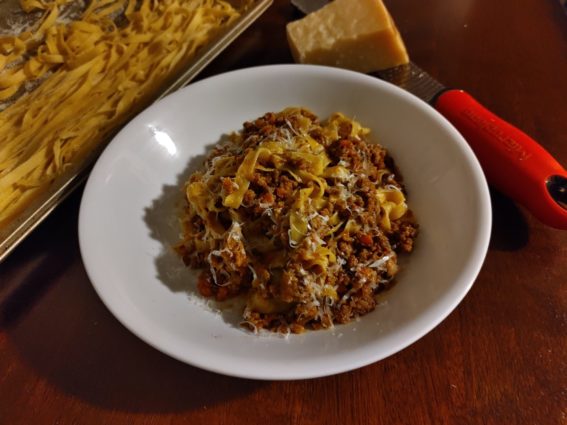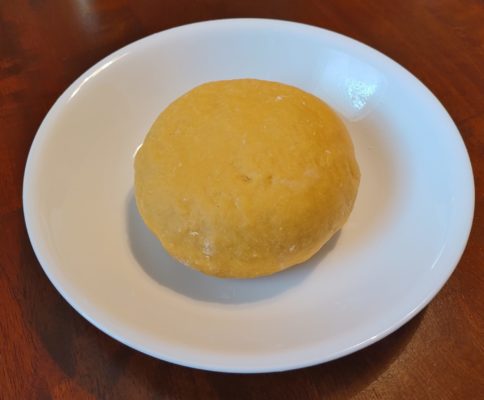Bolognese

I started this blog post with the intention of focusing on pasta dishes. I have a small amount of experience making fresh pasta and wanted to expand on that for this post. While deciding between “Mastering Pasta” by Marc Vetri or “Flour + Water” by Thomas McNoughton, my interest was piqued by a Bolognese recipe in “Mastering Pasta.” I fell into a rabbit hole, researching the thousands (okay, maybe it was dozens) of variations on this one idea. For example, just in my personal cookbook collection I found no fewer than six different recipes.
I know, you’re thinking, “But, Jason, it’s just a meat sauce, like you’d put on spaghetti. You know, spaghetti sauce. A company was even named after the Italian term for meat sauce. Of course there are many varieties, this is not worthy of a blog post.” I am taking the stance that Bolognese is so much more than, and so much better than, what we think of as spaghetti sauce.
First, I will argue Bolognese sauce does not go on spaghetti, but is mixed together with tagliatelle. Second, the variations. Oh, boy, the variations. Granted, some of the reason behind all the variations is chefs not wanting to steal recipes or serving something you can get at just any ol’ place. The variations include a selection of ingredients, collected from many sources: pancetta, beef, veal, pork, bacon, chicken livers, prosciutto, onion, celery, carrot, garlic, butter, white wine, red wine, heavy cream, milk, nutmeg, tomato paste, tomato sauce, stewed tomatoes, beef stock, vegetable stock, water.
My issue was this: many sources claim their creation is “based on the classic recipe.” So, I started thinking, “What is the classic recipe?” There was even mention of an official recipe on record in the Bologna Chamber of Commerce, decided upon by The Accademia Italiana della Cucina.
Here’s what I found about the “classic recipe:” In 1953, The Accademia Italiana della cucina (Italian Academy of Cuisine) was founded “to safeguard Italian culinary traditions and encourage their promotion in Italy and abroad.” In 1972, it was decided that tagliatelle must measure 8mm when cooked, cutting the dough to about 6.5-7mm should get you there after cooking. Then in 1982, the Accademia announced they had decided on an “official Bolognese recipe.” You can find it here, but you have to sign up for a free account and possibly translate to English. (Yes, I signed up for the free account.)
What I did: I used the fresh pasta recipe from “Mastering Pasta” and the classic Bolognese recipe from Accademia Italiana della Cucina, adjusted for an American on a budget. Also, I try to limit our sodium intake, so low-sodium bacon was my best option instead of pancetta. The selection from “Mastering Pasta” is pretty close to the official recipe.
First, I got the bolognese started, as it is supposed to simmer for a couple hours. A dash of olive oil in the pan, I added the brunoise celery, onion and carrot on a low-medium heat to sweat. Next, I added the diced bacon to render the fat. (I think in the future I will start with rendering the bacon, to cut down on the fat/oil in the sauce. Bacon fat shouldn’t reach its smoke point when sweating vegetables so I could avoid the olive oil.) Then the minced meat was added to brown (I used 90% lean ground beef and ground pork; the recipe calls for grinding your own meats). I then added tomato paste and tomato puree to mix, then added red wine and let it simmer. Lastly, near the end, I added a bit of heavy cream to smooth it all out. I loved this sauce and, when time allows, I will absolutely make it again.

While the sauce was simmering, I prepared the pasta. The recipe in “Mastering Pasta” uses only tipo 00 flour, durum flour, egg yolks, olive oil and water. Simple enough, it’s the basic dough used for a variety of pasta types, modify it for your own needs. The photos in the section explaining fresh pasta were very clear and helpful. Dough rolled out easily, I used my crank pasta machine I bought about a decade ago.
When the sauce neared its finishing point, I cooked the pasta. Now for the part that really brings it over the top, you mix the cooked pasta into the sauce. The added starch from the pasta really tied the dish together. Lastly, I topped the plated pasta with microplaned Parmesan.
I hope you enjoyed my digression into a bit of the history of Bolognese and that it may inspire you to research the origins of some dishes we may take for granted.


